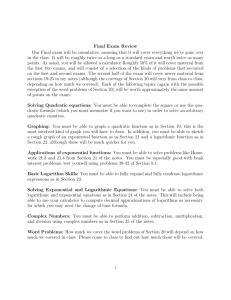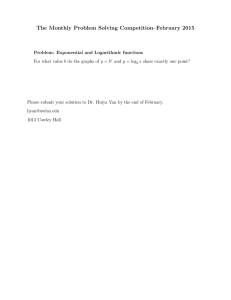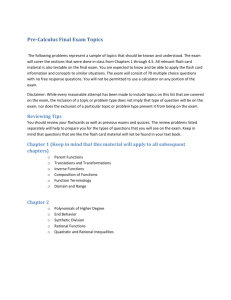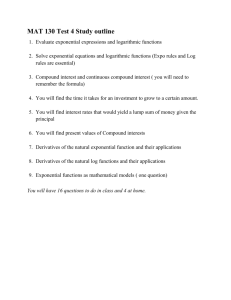Master Syllabus MTH 101 – Elements of College Math I
advertisement
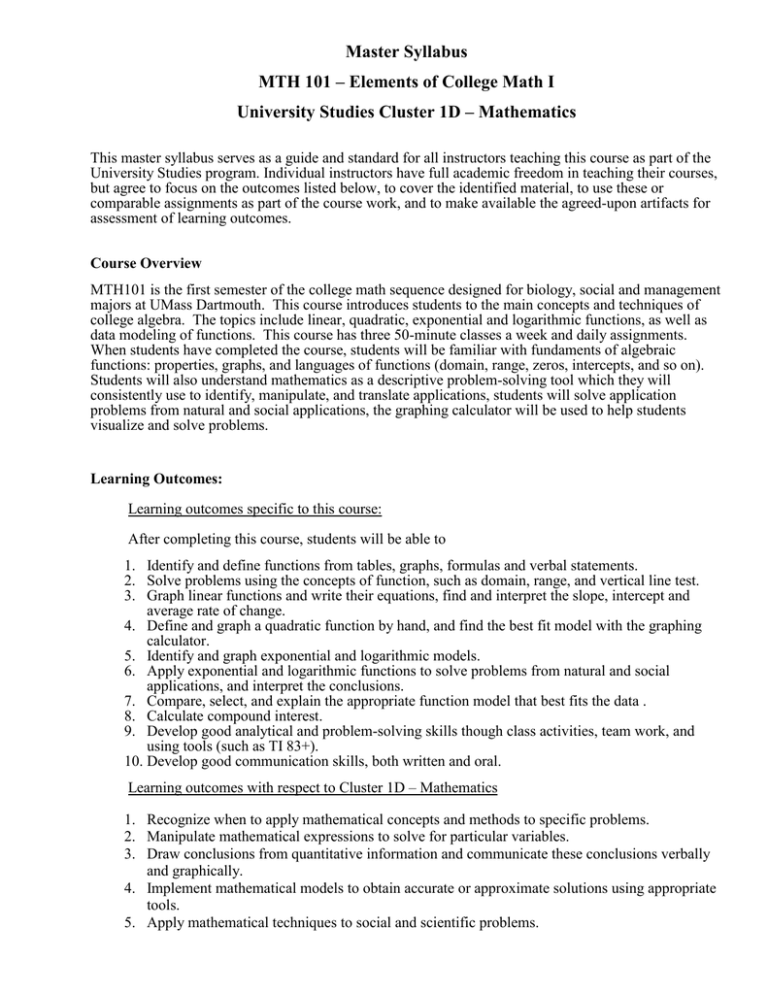
Master Syllabus MTH 101 – Elements of College Math I University Studies Cluster 1D – Mathematics This master syllabus serves as a guide and standard for all instructors teaching this course as part of the University Studies program. Individual instructors have full academic freedom in teaching their courses, but agree to focus on the outcomes listed below, to cover the identified material, to use these or comparable assignments as part of the course work, and to make available the agreed-upon artifacts for assessment of learning outcomes. Course Overview MTH101 is the first semester of the college math sequence designed for biology, social and management majors at UMass Dartmouth. This course introduces students to the main concepts and techniques of college algebra. The topics include linear, quadratic, exponential and logarithmic functions, as well as data modeling of functions. This course has three 50-minute classes a week and daily assignments. When students have completed the course, students will be familiar with fundaments of algebraic functions: properties, graphs, and languages of functions (domain, range, zeros, intercepts, and so on). Students will also understand mathematics as a descriptive problem-solving tool which they will consistently use to identify, manipulate, and translate applications, students will solve application problems from natural and social applications, the graphing calculator will be used to help students visualize and solve problems. Learning Outcomes: Learning outcomes specific to this course: After completing this course, students will be able to 1. Identify and define functions from tables, graphs, formulas and verbal statements. 2. Solve problems using the concepts of function, such as domain, range, and vertical line test. 3. Graph linear functions and write their equations, find and interpret the slope, intercept and average rate of change. 4. Define and graph a quadratic function by hand, and find the best fit model with the graphing calculator. 5. Identify and graph exponential and logarithmic models. 6. Apply exponential and logarithmic functions to solve problems from natural and social applications, and interpret the conclusions. 7. Compare, select, and explain the appropriate function model that best fits the data . 8. Calculate compound interest. 9. Develop good analytical and problem-solving skills though class activities, team work, and using tools (such as TI 83+). 10. Develop good communication skills, both written and oral. Learning outcomes with respect to Cluster 1D – Mathematics 1. Recognize when to apply mathematical concepts and methods to specific problems. 2. Manipulate mathematical expressions to solve for particular variables. 3. Draw conclusions from quantitative information and communicate these conclusions verbally and graphically. 4. Implement mathematical models to obtain accurate or approximate solutions using appropriate tools. 5. Apply mathematical techniques to social and scientific problems. Textbook Harshbarger Ronald J., and Yocco Lisa S., College Algebra in Context, 2nd Ed. (Custom Edition for UMass Dartmouth), Boston, Addition Wesley, 2010. Assignments Homework Assignments: Students should apply learned course material to complete daily assigned homework as listed in the syllabus, students are expected to submit homework neatly and timely. Quizzes: There are several 15 minute quizzes, the lowest quiz grade will be dropped. Tests: There are three in-class tests. Each test will ask students to apply knowledge and skills from the corresponding chapters to solve problems. The following Test 1 is designed to see the extent to which students have the computational and quantitative reasoning skills required for success in chapter 1 and the first two sections of chapter 2. Students are required to show complete work to support their final answer; calculators are allowed, and one formula sheet may also be used at the discretion of the instructor. The following map indicates which problems are associated with which of the five Gen Ed learning outcomes in mathematics. Suggested solutions and partial points for problem 1 are attached. The degree of success achieved on each learning outcome will be measured by the average percentage correct. Gen Ed Outcome Problems Points (Total 100) Recognize when to apply mathematical concepts and methods to specific problems. 1, 2 b) 22 Manipulate mathematical expressions to solve for particular variables. 2 a), 3 c) 13 Draw conclusions from quantitative information and communicate these conclusions verbally and graphically. 4 30 Implement mathematical models to obtain accurate or approximate solutions using appropriate tools. 5 20 Apply mathematical techniques to social and scientific problems. 3a), 3b) 15 Final Exam: The final exam will be cumulative, but weigh more heavily on the latter material. Course Outline Week 1 Chapter 1 Week 2 Chapter 1 Week 3 Chapter 1 Week 4-5 Chapter 2 Week 5 Chapter 3 Week 6 Chapter 3 Week 7 Chapter 3 Week 8 Chapter 3 Functions, Inverse Functions, Graphs, and Models Linear Functions, Equations of Lines Average Rate of Change, Approximately Linear Systems of Linear Equations in Two Variables Quadratic Functions, Parabolas, Highs and Lows Solving Quadratic Equations Piecewise-Defined Functions and Power Functions Modeling with Quadratic Functions and Power Functions Week 9 Week 10 Week 11 Week 12 Week 13 Week 14 Week 15 Chapter 4 Chapter 5 Chapter 5 Chapter 5 Chapter 5 Chapter 5 Review Additional Topics: Transformations of Graphs Exponential Functions, Natural Growth and Decay Logarithmic Functions, Properties of Logarithms Exponential And Logarithmic Equations Modeling with Exponential and Logarithmic Functions Compound Interest, Continuous Compounding .
